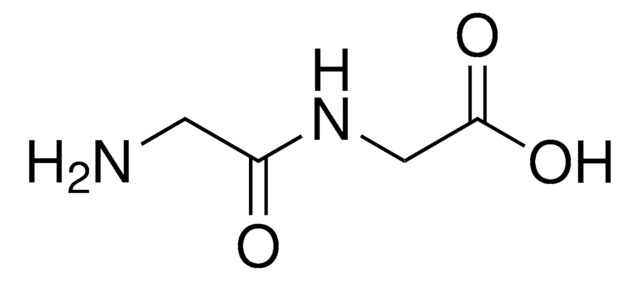50199
Gly-Gly
BioUltra, ≥99.5% (NT)
Synonyme(s) :
Diglycine, Glycyl-glycine
About This Item
Produits recommandés
Gamme de produits
BioUltra
Essai
≥99.5% (NT)
Forme
powder
Impuretés
insoluble matter, passes filter test
Résidus de calcination
≤0.05% (as SO4)
Perte
≤0.05% loss on drying, 110 °C
Couleur
white
pH
4.5-6.0 (20 °C, 1 M in H2O)
Plage de pH utile
7.5-8.9
pKa (25 °C)
8.2
Pf
220-240 °C
Solubilité
H2O: 1 M at 20 °C, clear, colorless
Traces d'anions
chloride (Cl-): ≤50 mg/kg
sulfate (SO42-): ≤50 mg/kg
Traces de cations
Al: ≤5 mg/kg
As: ≤0.1 mg/kg
Ba: ≤5 mg/kg
Bi: ≤5 mg/kg
Ca: ≤10 mg/kg
Cd: ≤5 mg/kg
Co: ≤5 mg/kg
Cr: ≤5 mg/kg
Cu: ≤5 mg/kg
Fe: ≤5 mg/kg
K: ≤50 mg/kg
Li: ≤5 mg/kg
Mg: ≤5 mg/kg
Mn: ≤5 mg/kg
Mo: ≤5 mg/kg
NH4+: ≤200 mg/kg
Na: ≤50 mg/kg
Ni: ≤5 mg/kg
Pb: ≤5 mg/kg
Sr: ≤5 mg/kg
Zn: ≤5 mg/kg
λ
1 M in H2O
Absorption UV
λ: 260 nm Amax: 0.075
λ: 280 nm Amax: 0.072
Chaîne SMILES
NCC(=O)NCC(O)=O
InChI
1S/C4H8N2O3/c5-1-3(7)6-2-4(8)9/h1-2,5H2,(H,6,7)(H,8,9)
Clé InChI
YMAWOPBAYDPSLA-UHFFFAOYSA-N
Informations sur le gène
human ... SLC15A1(6564)
Vous recherchez des produits similaires ? Visite Guide de comparaison des produits
Autres remarques
Code de la classe de stockage
11 - Combustible Solids
Classe de danger pour l'eau (WGK)
WGK 3
Point d'éclair (°F)
Not applicable
Point d'éclair (°C)
Not applicable
Équipement de protection individuelle
dust mask type N95 (US), Eyeshields, Gloves
Faites votre choix parmi les versions les plus récentes :
Déjà en possession de ce produit ?
Retrouvez la documentation relative aux produits que vous avez récemment achetés dans la Bibliothèque de documents.
Les clients ont également consulté
Notre équipe de scientifiques dispose d'une expérience dans tous les secteurs de la recherche, notamment en sciences de la vie, science des matériaux, synthèse chimique, chromatographie, analyse et dans de nombreux autres domaines..
Contacter notre Service technique





